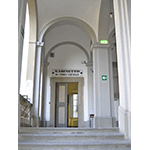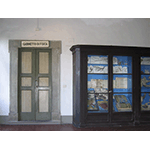Liceo Classico "Niccolò Machiavelli" ["Niccolò Machiavelli" Classical Secondary School]
The history of the School is strictly linked to the inauguration in Lucca of a university institute, opened in 1785 under the name of Pio Istituto di San Frediano [Devout Institute of San Frediano], after various attempts had been made since the 14th century. In 1790 a chair of chemistry was instituted, endowed with various instruments, which probably formed the core of the collection of scientific instruments formed later at the R. Liceo di Lucca [Lucca Royal Secondary School].
The educational reform implemented by Duchess Maria Luisa of Bourbon led to the foundation, in 1819, of the Royal Boarding School, housed in Palazzo Lucchesini. The Boarding School, the pride of public education in the Duchy, possessed a botanical garden, an astronomical observatory, a physics cabinet, an anatomical cabinet and a museum of natural history. The scientific cabinets were interesting enough to deserve mention in contemporary guides to the city, which recommended visiting them.
With the decree of February 28, 1837, Duke Charles Ludwig instituted within the Secondary School the Technical Schools for craftsmen, which had been conceived by the painter Michele Ridolfi. "Every Sunday", recalls Giovanni Sforza, "the craftsmen received instruction free of charge at the Royal Secondary School in theoretical, applied, and commercial arithmetic, in theoretical-practical geometry, in general physics, the principles of particular physics, industrial mechanics, general and special technical chemistry, agronomy, pasturage, principles of veterinary science and legal technical architecture".
Around the middle of the 19th century the Liceo, which had now taken on the functions of a university, had twenty-seven chairs, with three faculties: Law, Medicine and Surgery, Physics and Mathematics. The Faculty of Law offered a five-year course. Degrees in law were granted through an ancient privilege of the Archbishop. In the Faculty of Medicine and Surgery, the course lasted six years. Degrees were conferred by the Director of Public Education, who supervised teaching of all kinds in the Duchy. The authority of the Director, as regards public education, was subordinate only to that of the sovereign. In the Faculty of Physics and Mathematics, the course of studies lasted five years, with the academic year beginning in mid-November and enduing in mid-July, for about 140 days of lessons. Degrees were conferred by the Director of Public Education, who was also the Director of the Royal Secondary School.
In 1843, in the seventeenth-century Palazzo Lucchesini, the Fifth Congress of Italian Scientists was held. A few years later, consequent to the annexation of the Duchy of Lucca to the Grand Duchy of Tuscany (1847), the school was reorganised, losing its characteristics of university and, with the Unification of Italy, it was converted into a Classical Secondary School. On that occasion the Museum became the school's Cabinet of Natural History. In 1998 the Liceo "Machiavelli", which had continued to occupy premises in the historic Palazzo Lucchesini, was united with the Istituto Magistrale "Paladini", to form the Istituto Statale d'Istruzione Superiore "Machiavelli-Paladini".
The naturalist collection is organised in sections: mineralogy and palaeontology, with some 500 specimens; malacology, with over 2,000 specimens, classified as earth shells and seashells; fauna, consisting of specimens of birds, fish, crustaceans, mammals and reptiles, either stuffed or preserved in fluid; entomology and osteology. The display also includes the ornithological collection donated by Carlo Piaggia and the Mezzetti Herbarium I (Flora Lucensis Exsiccata), donated by the author to the Royal Secondary School, which contains 1,570 samples of plants, most of them collected by Abbot Mezzetti in the countryside around Lucca around the middle of the 19th century. Completing this section are two Egyptian mummies found at Thebes in 1820.
The collection of scientific instruments used in education, dating from the early 19th century to the 20th, contains about four hundred objects, in particular scales, a Gravesande device, pneumatic machines, precision lathes and glassware. The Physics Cabinet is housed in the old hemicycle hall, in which some of the classes are held today.
****************************
Texts by Graziano Magrini
English translation by Catherine Frost
Last update 03/gen/2008





